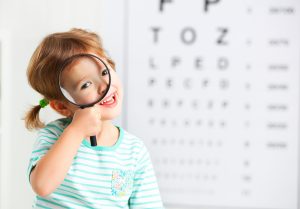About the study
The Modifying MYopia Control Efficacy (MMYCE) study will study whether behaviours such as spending time outdoors or spending time doing close-up work can modify the effectiveness of treatments used to prevent short-sightedness from getting worse. We will recruit young Australians aged 6-16 years currently receiving myopia control interventions and measure their outdoor and near work behaviours over 24 months. This will inform the development of guidelines and recommendations around outdoor and near work behaviors that lead to optimal treatment outcomes.
What is myopia?

Myopia or short-sightedness is a type of refractive error, caused by excessive growth of the eye. This elongation of the eye is strongly linked to risk of permanent vision loss in later life.
Myopia typically develops during childhood and adolescence and can continue to worsen until early adulthood. The prevalence and severity of myopia among successive generations of young Australians is increasing.
Our research has shown that over 30% of Australians aged 26–30 years have myopia. Increases in myopia rates are being driven by three major factors: 1) less time spent outdoors, 2) more time spent on near work, including digital devices, and 3) higher intensity of education.
How do you manage myopia?

Over the last five years, use of treatments to slow the rate of progression (worsening) of myopia after onset (called myopia control interventions) have entered clinical practice and become standard of care. Myopia control interventions include low-concentration atropine eye drops, orthokeratology and peripheral defocus spectacle and contact lenses. These interventions inhibit but do not completely stop, the progression of myopia with effectiveness varying among children.
There is evidence that the effectiveness of myopia control treatments decreased during the COVID-19 pandemic, when young people spent more time indoors at home and on near work devices. This finding implies that behaviours and environmental exposures could alter the effectiveness of myopia control treatments, such that spending high amounts of time indoors and engaged in near work could reduce the effectiveness of myopia control treatments.
There is a critical need to optimise the effectiveness of myopia control treatments, leading to reduced risk of vision loss later in life and to improve the cost effectiveness of treatment. Understanding how young people’s behaviours may interact with myopia control treatments is an essential step toward maximising the benefits of clinical myopia control interventions.
The findings from this study will help determine how behaviours that are known risk factors for myopia — time spent outdoors, and time spent on near work — modify the effectiveness of various forms of clinical myopia control treatments. It will enable us to produce recommendations for young people with myopia, their parents and clinicians on how much time outside and on near work young people should spend to maximise the benefits they receive from their myopia control treatment, while also adhering to appropriate sun safety guidelines.
What does participation in the study involve?
- Be informed about the study: Talk with your child about the study and determine whether they would like to participate. Talk to your current eye care provider to determine if the study is right for you.
- Consent for your child to participate in the study: Complete a consent form on behalf of your child after you have read this Parent Information Sheet and been given the opportunity to ask questions on the day of your examination.
- Attend a baseline visit at one of the study sites, where you will complete a questionnaire, your child will provide a saliva sample, and we will measure you child’s eye length and glasses prescription.
- You will need to attend a visit with your current eye care provider at 12 and 24 months after the beginning the study. Only selected eye clinics are participating in the study. Your eye care provider will be in contact to book these visits. Your eye care provider may require you to attend additional visits as part of your regular care.
- You or your child will be asked to complete an online survey every 3 months (over 12 months), asking about your child’s outdoor and near work (e.g. reading) behaviours.
- If selected for the light meter sub-study, your child will need to wear a light meter for one week. We will ask you to post the light meter back to the study team using a pre-paid parcel at the end of the week.
- Saliva sample: Provide a saliva sample for genetic analysis.
Participation in the study does not impact on the treatment your child receives from your current eye care provider. Visits for this study may overlap with, but do not replace, your regular eye care visits.
How to be involved in the study?
If you and your child are interested in participating in this study, please contact the study team at mmyce@lei.org.au.
Study approval
All research studies in Australia that involves human subjects have to be approved by a human research ethics committee, in this case this study has been approved by the University of Western Australia Human Research Ethics Committee (approval no.).
The ethical approval process involves a vigorous review of the proposed research study protocol and any treatment. It ensures that benefits to the scientific field outweigh the risks to research participants.
Potential risks of the study
Participants will receive eye drops to dilate their pupils at 12-monthly visits over 2 years. These eye drops are routinely used in eye care clinics and you may already be familiar with them. Participants may even receive these eye drops through standard of care at visits that coincide with the baseline, month 12 or month 24 visits. Nevertheless, some participants will receive eye drops who may not have otherwise had them at that visit. These eye drops cause a temporary stinging sensation (lasts <30 seconds) and will cause light sensitivity (due to dilated pupil) and some mild blurring of vision for approximately 24 hours. They may also cause redness, blurred vision, an increase in intraocular pressure and an allergic reaction. All side-effects are temporary.
About the team
This project is being led by researchers at the University of Western Australia and conducted in collaboration with researchers at the University of Melbourne, Macquarie University and Queensland University of Technology.

Principal investigator
Dr Gareth Lingham is an orthoptist and postdoctoral research fellow with substantial research experience in myopia and myopia-related behaviours across epidemiological and clinical trial settings in Australia and Ireland.
Contacts
If you would like to participate or discuss any aspect of this study, please contact Dr Gareth Lingham (mmyce@lei.org.au).
FAQs
Ethics review and complaints
Approval to conduct this research has been provided by The University of Western Australia (UWA), in accordance with its ethics review and approval procedures. Any person considering participation in this research project, or agreeing to participate, may raise any questions or issues with the researchers at any time.
In addition, any person not satisfied with the response of researchers may raise ethics issues or concerns, and may make any complaints about this research project by contacting the Human Ethics office at UWA on (08) 6488 4703 or by sending an email to humanethics@uwa.edu.au. All research participants are entitled to retain a copy of any Participant Information Form and/or Participant Consent Form relating to this research project.



